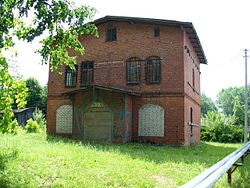Pillkaller Kleinbahn
| Pillkaller (Schloßberger) small train | |||||||||||||||||||||||||||||||||||||||||||||||||||||||||||||||||||||||||||||||||||||
|---|---|---|---|---|---|---|---|---|---|---|---|---|---|---|---|---|---|---|---|---|---|---|---|---|---|---|---|---|---|---|---|---|---|---|---|---|---|---|---|---|---|---|---|---|---|---|---|---|---|---|---|---|---|---|---|---|---|---|---|---|---|---|---|---|---|---|---|---|---|---|---|---|---|---|---|---|---|---|---|---|---|---|---|---|---|
|
Old train station Lasdehnen
| |||||||||||||||||||||||||||||||||||||||||||||||||||||||||||||||||||||||||||||||||||||
| Gauge : | 750 mm until 1916/17; then 1000 mm | ||||||||||||||||||||||||||||||||||||||||||||||||||||||||||||||||||||||||||||||||||||
| Pillkallen (Schloßberg) - Lasdehnen (Haselberg) | |||||||||||||||||||||||||||||||||||||||||||||||||||||||||||||||||||||||||||||||||||||
|
|||||||||||||||||||||||||||||||||||||||||||||||||||||||||||||||||||||||||||||||||||||
| Grumbkowkeiten (Grumbkowsfelde) –Schirwindt | |||||||||||||||||||||||||||||||||||||||||||||||||||||||||||||||||||||||||||||||||||||
|
|||||||||||||||||||||||||||||||||||||||||||||||||||||||||||||||||||||||||||||||||||||
| Kiauschen-Doristhal | |||||||||||||||||||||||||||||||||||||||||||||||||||||||||||||||||||||||||||||||||||||
|
|||||||||||||||||||||||||||||||||||||||||||||||||||||||||||||||||||||||||||||||||||||
The Pillkaller Kleinbahn was a small railway company in the East Prussian district of Pillkallen, which from 1938 was called the district of Schloßberg (Ostpr.) ; from this point on, the railway operated as the Schloßberger Kleinbahn .
history
The East Prussian district of Pillkallen, located directly on the Russian and later Lithuanian border, and its capital were not connected to the state railway network until 1892/93 by the Tilsit – Stallupönen (Ebenrode) branch line . Further railway construction was left to the Pillkaller Kleinbahn-AG, which was founded on June 25, 1900 by the Kingdom of Prussia, the province of East Prussia , the district and the railway construction company Lenz & Co. GmbH.
Most of the rail network was opened on December 24, 1901. This initially included the 30 km long "main axis", which ran from the district town with a bulge to the east via Grumbkowkeiten (Grumbkowsfelde) and Kiauschen (Wetterau) to the north to the church village of Lasdehnen (Haselberg). In the two intermediate stations mentioned, branch lines branched off in an easterly direction.
The first was 20 kilometers long and led from Grumbkowkeiten via Willuhnen to the border town of Schirwindt , which was then the easternmost town in the German Empire. The second branch line from Kiauschen initially ended in Schillehnen (Schillfelde) and was only extended by five kilometers to Doristhal on November 7, 1906. After that, the small railway network covered a length of 61 kilometers.
It was initially laid out in the narrow gauge of 750 mm, but was largely destroyed by Russian troops in World War I in 1914, so that operations were suspended from August 12, 1914 to April 2, 1915. Then he could be temporarily resumed. On December 4, 1915, the general assembly of the AG passed the resolution to change the gauge to 1000 mm, as most of the operating resources had been destroyed and had to be newly procured anyway. But the positive development of the railway in its previous operating time also played a role. Because the railway was needed to rebuild the localities, the building materials were delivered urgently. In addition to state funds, this was also made possible with donations, there were also sponsorships from places in other areas of Germany for the reconstruction of the East Prussian places. From November 13, 1916, this change of gauge was carried out during ongoing operations, and on July 12, 1917, the meter-gauge railway was fully operational.
The small train station in Pillkallen was right next to the Reichsbahnhof, and there was a double-track reloading point for goods traffic. The workshop was also here.
The Ostdeutsche Eisenbahn-Gesellschaft in Königsberg (ODEG) took over the management . On June 30, 1924, the Pillkaller Kleinbahn-AG was incorporated into the Insterburger Kleinbahn-AG, which was then called Ostpreußische Kleinbahnen AG .
The railway facilities were largely destroyed in the course of the war in the winter of 1944/45. They were not rebuilt afterwards.
traffic
Every day there were three pairs of passenger trains on the route, in Grumbkowkeiten and Kiauschen a connection was planned, there were even through coaches.
In Schirwindt there was a considerable turnover of wood and grain from Russia and Lithuania.
vehicles
In 1939 the following vehicles were available: five steam locomotives , twelve passenger cars, three pack wagons and 93 freight cars. There were also four snow plows, which were stationed at the end points, to quickly clear the tracks from snow. Some bus routes also operated by the ODEG supplemented the transport offer from August 15, 1931. They drove from Pillkallen to Lasdehnen, Schillehnen, Schirwindt and Stallupönen.
One of the steam locomotives has been preserved and is now in service with the German Railway Association . Another locomotive was used in the Palatinate until 1957.
literature
- Siegfried Bufe: Railways in West and East Prussia. Bufe-Fachbuch-Verlag, Egglham 1986, ISBN 3-922138-24-1 .
- Jörg Petzold: Again: Locomotive SPREEWALD . In: The Museum Railway . No. 2 , 2007, ISSN 0936-4609 , p. 37-40 .
- Jörg Petzold: The last weeks of the Pillkaller / Schloßberger Kleinbahn . In: The Museum Railway . No. 3 , 2017, ISSN 0936-4609 , p. 40-44 .

